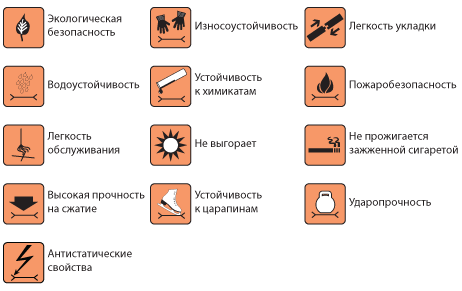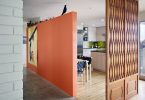Choosing a laminate is not as easy as it might seem. There are a number of nuances to be aware of if you are going to buy this type of floor covering. First you need to understand the classifications and designations. But let’s talk about everything in order..
Laminate classes
Each class of laminate has a certain durability. It depends on this parameter – how long the laminated coating can serve you. To unify the quality assessment of laminate in 1999, special standards were introduced, which were approved by the European Association of Manufacturers of Laminate Floors. European standards contain a classification of laminates based on their durability. After testing, the floors receive a class of use (exploitation).
The service class determines how long the laminate will be able to maintain its appearance under various loads and harmful effects. A European standard (EN 13329) has been developed – it contains 18 tests, after which the laminate is assigned a certain class. This regulation provides for the division of laminate flooring into two groups – laminates for commercial use and laminates for home use. Previously, the main criterion for determining the class of application was the wear resistance test, for which a special device equipped with a grinding wheel was used..
Now, in order to assign a class of application, the laminate is tested according to 7 parameters:
wear resistance; resistance to pollution; indentation resistance; resistance to moving furniture; resistance to a lit cigarette; moisture resistance; resistance to moving furniture on casters.
After testing, the laminate is rated for the lowest test result. For example, if, according to the results of the first six tests, the laminate corresponds to class 33, and according to the seventh – to class 21, then the material will receive the 21st class of use..
Laminate class 21
Class 21 laminate is designed for light loads. The service life of such a laminate is short, it rarely even reaches 4 years. Suitable for use in closets and bedrooms. Today, such a laminate is almost never found, since it is not in demand on the market..
Class 22 laminate
Class 22 laminate is suitable for use in children’s rooms and living rooms. It is clear that it can also be used in residential areas. The service life is up to 4 years.
Laminate 23 class
Class 23 laminate flooring is used for residential premises where the load on the floors is high, for example, where there is a lot of heavy furniture. These rooms include hallways and kitchens. Service life up to 4 years.
Laminate class 31
Laminate class 31 is intended for commercial buildings where there is a small load on the floors. It is of a higher quality than residential laminate. It can be stacked in conference rooms. In this case, the service life will be up to 3 years. If you lay such a laminate in a residential building, then it can last up to twelve years..
Class 32 laminate
Class 32 laminate flooring is suitable for use in commercial spaces where floor loads are moderate, such as reception areas, offices, classrooms and similar locations. The service life for such premises will be up to 5 years. For residential premises, the service life of this laminate is up to 15 years.
Class 33 laminate
Class 33 laminate is used for flooring in commercial premises where there is a large load on the floor. First of all, these are: bars, restaurants, shops and gyms. Service life – maximum 6 years. When laid in a residential area, such a laminate can be used for up to 24 years..
Tip: It is generally accepted that class 32 laminate is best suited for offices and apartments. He has the most optimal price / quality ratio.
If you are looking for laminate flooring in a commercial space, then you need to choose from 32 classes. It will justify the investment and will last up to 6 years. In case you need a laminate for your home, it is better to take a material of at least 31 classes, its quality will be higher than that of a laminate intended for use in residential premises. Accordingly, the service life will also be longer..
Laminate thickness
The thickness of the laminate can be 6 to 12 millimeters. It is better to choose thicker laminate, as the thicker it is, the stronger it is, and it is easier to install. In addition, the thicker the coating, the higher the sound absorption properties..
Based on the above, it makes sense to choose a laminate with a thickness of 8-12 millimeters.
Laminate manufacturers
The majority of manufacturers give a guarantee for a period of 5 to 15 years. But still it is better to give preference to the laminate of well-known manufacturers. For example, such as: Tarkett, Alloc, Pergo and others.
Typically, reputable manufacturers guarantee a lifespan of over 20 years, and Alloc laminates have a lifetime warranty. Only cheap coatings wear out quickly, so they have a minimum warranty period..
Connection types
There are two types of joining laminate panels:
Adhesive laminate is cheap, but you will have to hire professionals to install it, since it will be difficult to do it yourself. The panels must be connected with their ends using quick-drying glue. The use of glue eliminates gaps. For this reason, an adhesive laminate has a higher moisture resistance than a castle one. The disadvantages include the impossibility of repairing such a coating, since the panels are glued together, which means that it will not work to replace the damaged area without spoiling the neighboring panels.
The castle laminate is laid without glue – due to the special design of the panels. This laminate is highly maintainable as its panels are not glued together. The main disadvantage of this connection option is that the joints are exposed to moisture. True, some manufacturers are trying to solve this problem by recommending to use glue when laying to fasten the panels..
There are two types of lock laminate: latch locks (lock) and collapsible locks (click).
Laminate with click locks is easy to install, these locks are double and are angled at 45 degrees. They allow a base curvature of up to 3 millimeters per linear meter..
Panels equipped with lock locks can be installed even easier than with click locks. You don’t even need professional skills to work with them. But for such panels, the base is made perfectly flat..
Types of underlays for laminate
The underlay is a special material used to isolate the laminate from the floor. Before laying it, you need to well clean the floor surface from debris with a vacuum cleaner. The backing provides sound insulation and thermal insulation. There are laminates that already have a substrate, as a rule, these are laminates from class 32.
There are such types of substrate if you take into account the material:
The foam backing is the most common. The advantages of such a substrate are moisture resistance, low price and ease of use. Disadvantages – it does not hold its shape well and sags over time, loses its properties when exposed to sunlight. A cork backing is an excellent heat insulator. It holds its shape well and is very durable. However, condensation often forms on such a substrate. Substrates made of cork and bitumen or cork and rubber are devoid of this disadvantage. Such substrates do not wear down and are well cushioned. The special underlay allows the panels to be laid much faster. At the same time, excellent heat and sound insulation is provided, condensation does not form. The disadvantage of this substrate is the high price..
Graphic symbols on the laminate will help you make your choice. Therefore, before going to the store, study – what each of them means.







